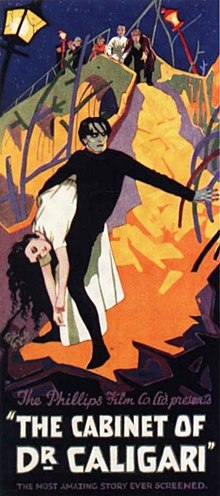Director: Robert Wiene
Cast: Werner Krauss, Conrad Veidt, Friedrich Fehér, Lil Dagover, Hans Twardowski
Haven't done an edition of Saturday Night Horror in a while! This week, we'll be reviewing a film from the German expressionist period that I've been wanting to see for quite some time: THE CABINET OF DR. CALIGARI.
THE PLOT: CALIGARI is, as the opening cue card states, a tale of the modern re-appearance of an 11th century myth involving the strange and mysterious influence of a mountebank monk over a somnambulist. In layman's terms, a crazy monk influences a sleepwalker.
The opening sequence begins and we see a young woman, Jane (Lil Dagover) who seems to be sleepwalking. The protagonist, Francis (Friedrich Fehér) claims her to be his betrothed, and begins to tell a story about their life together. Caligari is one of the earliest examples of the use of the flashback technique in a film.
Francis and his friend Alan (Hans Twardowski) decide to go to a fair that has arrived in their fictional town of Holstenwall. With the fair comes a mountebank (Werner Krauss) who is revealed via business card to be Dr. Caligari. He wants a permit to showcase his concession, Cesare (Conrad Veidt), a somnambulist, at the fair. The town clerk, who is in a bad mood and figures nothing can go wrong, gives it to him. Big mistake, as the next cue card will inform us.
That night, the first of a series of strange murders occurs. The first victim is the town clerk, and if you're like me, you're assuming that Dr. Caligari is instructing Cesare on who to kill.
The next day, Francis and Alan go to see the show. Caligari claims that Cesare knows all secrets and asks the patrons to ask him their future. Alan asks the man how long he will live and Cesare replies that he will die at dawn. Another cliché but effective horror movie trait.
Later that night, Alan is awoken by Cesare, who proceeds to murder him, fulfilling the prophecy. When Francis hears of the news that his friend has been murdered the next day, he tells the police and everyone he knows, including the town doctor, Dr. Olsen (Rudolf Lettinger). Surprisingly, he believes him and tells him he will ask the police for permission to examine him. I bet The Boy Who Cried Wolf wishes he were this lucky.
In what may be the earliest parody of terrible police work, the cops catch who they think is the murderer. This guy says he tried to kill an old woman, but that he had nothing to do with the other two killings, and for once, the accused is telling the truth. Take THAT, Law & Order!
Meanwhile, Jane is worried about her father, Dr. Olsen. She goes looking for him and happens upon Dr. Caligari's tent. The doctor shows her Cesare, and naturally, Jane being the heroine, has to become afraid.
Cesare's next murder is probably one of the more famous scenes in German expressionist film history. As he attempts to murder Jane, he realizes he cannot do it because he has fallen in love with her (of course. *rolls eyes*). He then leaves her for the cops to find.
While Caligari sleeps, Francis and the doctors at the insane asylum he has been admitted to sneak into his room. There, they find a book that is Caligari's "special study," according to Francis. The book reveals that in 1093 there was a monk named Caligari who traveled to northwestern Italy with his somnambulist, Cesare. Is Caligari a vampire? Let's find out...
Well, we don't know about the vampire thing yet, but we were right about Caligari ordering Cesare to attack the victims of Caligari's choosing. We also now know that Caligari is not really the Caligari mentioned in the book, but is desperately trying to become him, and when a somnambulist is admitted to the asylum, he gets his chance.
The next morning, however, Cesare is found dead in a ravine. The madman Caligari is placed in a straitjacket and we return to the present day, where Francis explains that the man is still a raving lunatic confined in his cell. The two men return to the asylum where Francis points out to his companion Cesare. He sees Jane and asks her when she will marry him. She replies that she is of royal blood and can't follow the wishes of her heart. Caligari steps out and Francis becomes quite mad himself, shouting that the man is Caligari and he is plotting their downfall and that they die at dawn. The film ends with Caligari believing that Francis believes him to be the mythical Caligari.
THE REVIEW: It's ironic because this film is about as long as an episode of LES VAMPIRES and Francis resembles Philippe Guèrande in a way.
Murnau's NOSFERATU is often touted as an expressionist film, and it is, but CALIGARI goes above and beyond when it comes to expressionism. Odd landscapes run rampant in this film. Even the trees are oddly shaped and creepy. The doors on the buildings too are slanted. The whole thing looks like it was filmed on a movie set, which it probably was. The music throughout the film really is textbook horror movie music. I'd give this film 4 out of 5 stars. Good early German expressionalism suspense/horror film.
Full movie, courtesy of YouTube:

No comments:
Post a Comment